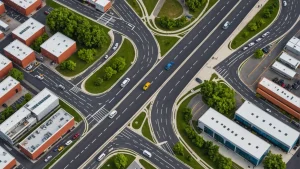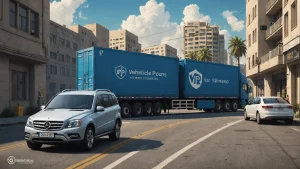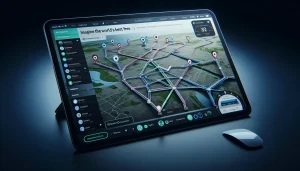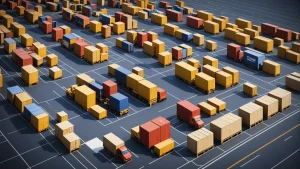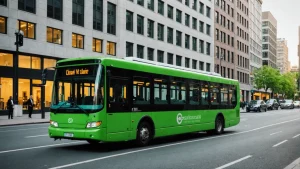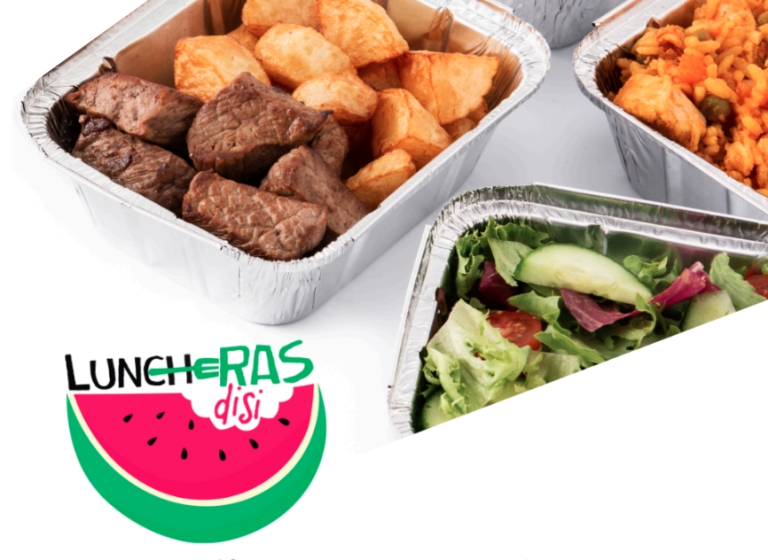Struggling to keep up with the growing demand for your delivery services?
The key to scaling your business lies in optimizing your delivery routes. By leveraging advanced algorithms and real-time data, you can minimize travel time, reduce fuel consumption, and maximize your delivery capacity. Unlock the potential of optimizing your delivery paths by diving into how route optimization technology can revolutionize your business logistics and efficiency.
Imagine being able to handle more orders, keep your customers happy, and boost your bottom line – all without expanding your delivery fleet or hiring more drivers. That’s the power of delivery route optimization. Discover how planning routes with multiple stops can streamline your operations, leading to enhanced efficiency and cost savings.
Benefits of Delivery Route Optimization
Reduce fuel costs and improve profitability
Streamline routes to increase delivery capacity
Enhance customer satisfaction with faster, reliable deliveries
Minimize fuel and labor costs with proper route optimization tools
Create the shortest route most efficient route for each delivery
Enhance logistics operations through efficient route planning
Reduced Fuel Consumption and Costs
Optimizing delivery routes is one of the most effective ways to reduce fuel consumption and costs for businesses. By minimizing the total distance traveled by each vehicle, companies can significantly lower their fuel expenses. This is especially important as fuel prices continue to fluctuate and impact bottom lines. Reduce your fuel expenses and enhance efficiency by mastering route optimization with Google Maps, a smart strategy for minimizing travel distances and costs.
Overall Driver Wages & Fuel Costs:
Driver wages and fuel costs gobble up nearly 60% of the total operational cost per mile.
Reduced Fuel Costs with Efficient Route Planning:
Route optimization helps to reduce fuel costs up to 30%.
Increased Profitability
Lower fuel costs directly contribute to increased profitability for businesses. By allocating the money saved on fuel towards other areas of the business, such as expanding the fleet, hiring more drivers, or investing in new technology, companies can further optimize their operations and grow their bottom line.
Moreover, the cost savings from reduced fuel consumption can be passed on to customers in the form of competitive pricing or improved services, helping businesses gain a competitive edge in their market.
Improved Delivery Efficiency and Capacity
Route optimization streamlines delivery routes, allowing drivers to complete more deliveries per day without expanding the fleet size. By minimizing the time spent navigating between destinations multiple stops, drivers can focus on making prompt deliveries and providing excellent customer service. Unlock higher productivity levels with delivery route planning software, boosting your operation’s overall delivery performance.
Efficient routing also helps businesses better utilize their existing fleet capacity. With optimized routes, companies can take on more orders and increase their delivery volume without purchasing additional vehicles or hiring more drivers. This is particularly beneficial for businesses looking to scale their operations and accommodate growth.
Increased On-Time Deliveries:
Route optimization software like DispatchTrack can lead to a significant boost in on-time deliveries, with users reporting rates as high as 98%.
Enhanced Customer Satisfaction
Delivery route optimization directly impacts customer satisfaction by enabling faster, more reliable deliveries. When routes are optimized, customers receive their orders promptly, improving their overall experience with the business.
Accurate estimated time of arrivals (ETAs) and real-time tracking are critical components of a positive customer experience. By providing customers with precise delivery windows and the ability to track their orders in real-time, businesses can keep customers informed and reduce the uncertainty associated with waiting for deliveries.
Efficient Routes, Satisfied Customers:
A study by Capgemini found that 3 in 4 customers are willing to pay more for faster delivery services.
Improved Driver Satisfaction and Retention
Optimized routes not only benefit customers but also contribute to improved driver satisfaction and retention. When routes are well-planned and efficient, drivers experience less stress and frustration on the road. They can complete their deliveries more easily, without the need to rush or navigate through congested areas.
Better working conditions lead to higher job satisfaction among drivers, reducing turnover rates and the costs associated with hiring and training new employees. This is particularly important in an industry where driver shortages are common and can significantly impact a business’s ability to meet customer demands.
Moreover, optimized routes help ensure that drivers comply with hours of service regulations, minimizing the risk of overworking and burnout. By prioritizing driver well-being, businesses can foster a positive work environment and maintain a reliable, experienced workforce.
Reduced Carbon Footprint and Environmental Impact
In addition to the financial and operational benefits, delivery route optimization plays a crucial role in reducing a business’s carbon footprint and environmental impact. By minimizing the total distance traveled and idling time, optimized routes help reduce greenhouse gas emissions and contribute to cleaner air quality.
As consumers become increasingly environmentally conscious, businesses that demonstrate a commitment to sustainability gain a competitive advantage. Optimizing delivery routes not only helps companies meet their sustainability goals but also appeals to eco-conscious customers who prioritize environmentally friendly practices when choosing a business to support.
Furthermore, governments and regulatory bodies are implementing stricter emissions standards and carbon taxes, making it essential for businesses to adopt eco-friendly practices to remain compliant and avoid additional costs. By embracing route optimization, companies can proactively address these challenges and position themselves as leaders in sustainable delivery operations.
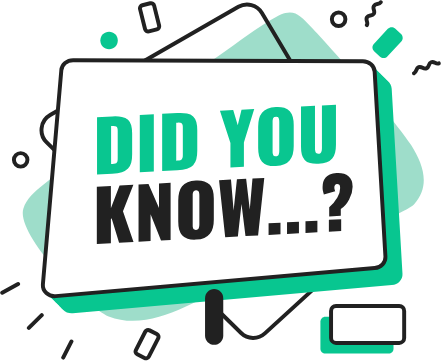
Delivery notifications and tracking improve customer satisfaction by 27%.
Metrobi automatically notifies your receivers of ETAs, provides delivery tracking, and collects delivery feedback.
Streamlining Delivery Operations with Route Optimization
Efficient Resource Utilization
Route optimization is crucial for streamlining delivery operations and ensuring efficient resource utilization. By optimizing routes, businesses can balance the workload among drivers, minimizing idle time and maximizing vehicle capacity utilization. This leads to improved productivity and cost savings. Enhance your supply chain efficiency by leveraging route optimization through Google Maps, effectively minimizing expenses while amplifying delivery speed.
Delivery Efficiency:
According to Aptean, on average, businesses that shift from manual to automated vehicle routing can cut route time and miles by 10-30%.
Balanced Workload Distribution
Optimized routes take into account factors such as delivery locations, delivery time windows, and driver availability. By assigning deliveries strategically, route optimization software ensures that each driver has a balanced workload. This prevents overworking some drivers while underutilizing others, leading to a more efficient and fair distribution of tasks.
Maximizing Vehicle Capacity
Route optimization also takes into consideration the capacity of each vehicle. By carefully planning the loading and unloading of goods, businesses can maximize the space utilization of their delivery vehicles. This reduces the need for multiple trips or additional vehicles, resulting in cost savings and reduced carbon emissions.
Drive Less, Pollute Less:
The Environmental Protection Agency (EPA) estimates that every gallon of fuel saved reduces carbon emissions by 22.2 pounds.
Seamless Integration with Existing Systems
To truly streamline delivery operations, route optimization software must integrate seamlessly with existing systems. This includes order management systems, GPS tracking devices, and customer communication platforms. Integration enables end-to-end visibility and control over the entire delivery process.
Order Management Integration
Route optimization software can pull data directly from order management systems, eliminating manual data entry and reducing the risk of errors. As new orders come in, the routing software automatically incorporates them into the optimized routes. This real-time synchronization ensures that drivers always have the most up-to-date delivery information.
GPS Tracking Integration
Integrating route optimization with GPS tracking systems allows for real-time monitoring of vehicle locations and progress. Dispatchers can track the status of each delivery, identify any deviations from the planned route, and make necessary adjustments. This level of visibility enhances communication between the delivery drivers, and the back office, enabling proactive problem-solving and improved customer service.
Real-time Data and Dynamic Route Adjustments
Route optimization is not a one-time process. It requires continuous monitoring and adjustments based on real-time data. By leveraging advanced algorithms and machine learning, route optimization software can dynamically adapt the best routes, in response to changing conditions.
Traffic and Weather Updates
Real-time traffic and weather data can significantly impact delivery times. Route optimization software can integrate with external data sources to monitor current conditions and predict potential delays. By dynamically adjusting routes based on this information, businesses can minimize the impact of traffic congestion or adverse weather on their delivery operations. According to a study by the Federal Highway Administration, real-time traffic information can reduce travel times by up to 20%. Discover how Route Planning for Multiple Stops can transform your delivery efficiency by considering real-time conditions, ensuring timely deliveries despite traffic and weather challenges.
Customer Preferences and Feedback
Customer preferences and feedback play a crucial role in optimizing delivery routes. Route optimization software can incorporate customer-specific requirements, such as preferred delivery times or special instructions. Additionally, by analyzing customer feedback and satisfaction scores, businesses can identify areas for improvement and make data-driven decisions to enhance the overall delivery experience.
Faster Deliveries = Happier Customers:
A study by the Harvard Business Review found that customer satisfaction increases by 20% when delivery times are flexible and meet customer preferences.
Late Deliveries = Lost Customers:
Nearly 70% of customers won't reorder if delivery is late, highlighting the importance of route optimization for on-time deliveries.
In summary, streamlining delivery operations with route optimization involves efficient resource utilization, seamless integration with existing systems, and leveraging real-time data for dynamic route adjustments. By optimizing routes, businesses can improve productivity, reduce operating costs further, and enhance customer service.
What is Delivery Route Optimization?
Delivery route optimization is the process of finding the most efficient routes for delivery vehicles to minimize travel time, fuel consumption, and cost. Advanced algorithms and real-time data are used to plan and optimize delivery routes dynamically, maximizing delivery capacity and customer satisfaction. Discover how advanced routing software can enhance your delivery efficiency, cut down on expenses, and revolutionize the way your logistics operations function.
The Complexity of Delivery Route Optimization
Delivery route optimization is a complex problem that involves many variables and constraints. The goal of route planners is to find the most efficient routes for delivery vehicles while considering factors such as:
Vehicle capacity and type
Driver availability and schedules
Customer time windows and preferences
Traffic conditions and road restrictions
Weather and other external factors
Solving this problem requires advanced algorithms that can process vast amounts of data and generate optimal solutions in real-time. These algorithms use techniques from operations research, graph theory, and artificial intelligence to find the best possible routes. Discover how algorithms for optimizing routes transform massive datasets into efficient paths, enhancing business operations by minimizing distances traveled.
The Traveling Salesman Problem
At its core, delivery route optimization is a variant of the famous Traveling Salesman Problem (TSP). The TSP asks: given a list of cities and the distances between each pair of cities, what is the shortest possible route that visits each city exactly once and returns to the origin city?
The TSP is an NP-hard problem, meaning that it is computationally difficult to solve optimally for large instances. Delivery route optimization adds even more complexity by introducing additional constraints and dynamic factors. Delve deeper into how the TSP, or travelling salesman dilemma, adapts to address the intricacies of modern delivery systems and route planning.
Real-World Examples of Delivery Route Optimization
Many companies have successfully implemented delivery route optimization to improve their operations and customer service. Here are a few notable examples:
UPS and ORION
UPS, one of the world’s largest shipping and logistics companies, uses a proprietary system called On-Road Integrated Optimization and Navigation (ORION) to optimize delivery routes for its fleet of over 120,000 vehicles. ORION uses advanced algorithms and real-time data to generate optimal routes, saving UPS millions of dollars in fuel costs and reducing its carbon footprint.
Amazon and Dynamic Delivery
Amazon, the e-commerce giant, employs a dynamic route optimization system to plan efficient delivery routes for its vast network of delivery partners. The system constantly updates routes based on new orders, traffic conditions, and other factors, ensuring that customers receive their packages as quickly and efficiently as possible.
Static vs. Dynamic Route Optimization
There are two main types of delivery route optimization algorithms: static and dynamic.
Static Route Optimization
Static route optimization is planned in advance based on historical data and known constraints. It is suitable for recurring deliveries with predictable demand, such as regular milk or newspaper deliveries. Static routes are often optimized on a weekly or monthly basis and do not change much from day to day. Explore how optimizing routes dynamically can further enhance efficiency for varying demand in logistics operations, compared to static planning.
Dynamic Route Optimization
Dynamic route optimization, on the other hand, adjusts routes in real-time based on changing conditions and new orders. It is ideal for businesses with fluctuating demand and last-minute orders, such as food delivery or e-commerce. Dynamic routes are continuously updated throughout the day to ensure that deliveries are made as efficiently as possible.
The Future of Delivery Route Planning Software
As technology continues to advance, delivery route optimization is becoming more sophisticated and powerful. Some of the latest trends and developments in this field include:
Machine learning and AI-based optimization algorithms
Integration with IoT devices and sensors for real-time data collection
Collaborative optimization across multiple delivery partners and platforms
Autonomous vehicles and drones for last-mile delivery
These innovations have the potential to revolutionize the delivery industry, making it faster, cheaper, and more sustainable. Companies that invest in delivery route optimization today will be well-positioned to scale their operations and stay competitive in the years to come.
How Does Delivery Route Optimization Work?
Delivery route optimization is a complex process that involves collecting data on delivery addresses, vehicle capacities, and traffic conditions, using advanced algorithms to calculate efficient routes considering multiple factors, and dynamically adjusting routes based on real-time updates and disruptions. Understand the intricacies of solving the vehicle routing dilemma and how it revolutionizes efficient delivery systems and route planning.
Data Collection and Analysis
Delivery route optimization process begins with gathering essential data points. This includes delivery addresses, vehicle capacities, driver availability, and traffic conditions. Historical data is also analyzed to identify patterns and constraints that may impact route efficiency. Unleash the potential of optimizing delivery routes to elevate efficiency and effectiveness in your distribution network.
For example, if a particular area consistently experiences heavy traffic during certain hours, the optimization system can factor this into the route planning process. By considering historical data, the system can predict potential bottlenecks and adjust routes accordingly.
Key Data Points for Route Optimization
Delivery addresses and locations
Vehicle capacities and specifications
Driver availability and schedules
Traffic patterns and congestion levels
Historical delivery data and trends
Route Calculation and Optimization
Once the necessary data is collected and analyzed, the delivery route optimization system employs advanced algorithms to calculate the most efficient routes. These algorithms consider multiple factors, including:
Distance between delivery points
Estimated travel time based on traffic conditions
Vehicle capacity and load constraints
Delivery windows and time slots
Driver availability and schedules
The optimization process aims to minimize the total distance traveled, reduce fuel consumption, and ensure timely deliveries while adhering to any constraints or limitations. Curious about what sets truck routing apart from everyday navigation tools? Discover the intricacies involved in planning routes for trucks.
Various algorithms, such as the Traveling Salesman Problem (TSP) and the Vehicle Routing Problem (VRP), are used in route optimization. These algorithms can handle complex scenarios involving multiple routes, vehicles, time windows, and capacity constraints.
Real-time Route Adjustment
In today’s dynamic business environment, last-minute changes and disruptions are common. Delivery route optimization systems must be able to adapt to these changes in real-time to maintain efficiency and customer satisfaction.
Real-time route adjustment involves dynamically updating routes based on current traffic conditions, weather changes, and order updates. For instance, if a new high-priority order comes in or a vehicle breaks down, the optimization system can quickly recalculate routes to accommodate these changes.
By leveraging real-time data from GPS tracking, traffic sensors, and weather reports, the optimization system can make informed decisions and provide drivers with the most up-to-date and efficient routes.
Benefits of Real-time Route Adjustment
Improved responsiveness to changing conditions
Reduced delivery delays and increased on-time performance
Enhanced customer satisfaction through timely deliveries
Increased flexibility to accommodate last-minute orders or changes
Integration with Delivery Management Systems
To maximize the effectiveness of delivery and route management and optimization, it is essential to integrate the optimization system with existing delivery management systems. This integration allows for seamless data exchange and enables the optimization system to access real-time information on orders, vehicle locations, and driver statuses.
Integration also facilitates the automatic updating of delivery schedules and driver assignments based on the optimized routes. This eliminates the need for manual intervention and ensures that all stakeholders, including drivers, dispatchers, and customers, have access to the most current and accurate information.
Continuous Optimization and Learning
Delivery route optimization is not a one-time event but rather an ongoing process. As businesses grow and delivery networks expand, the optimization system must continuously learn and adapt to new challenges and opportunities.
By regularly analyzing historical data and performance metrics, the optimization system can identify areas for improvement and fine-tune its algorithms. This continuous optimization ensures that routes remain efficient and effective over time, even as the business landscape evolves.
Maximizing Delivery Capacity with Route Optimization
Route optimization is a powerful tool for businesses looking to scale their delivery operations. By maximizing delivery capacity, companies can handle more orders without increasing their fleet size or hiring additional drivers. This section will explore the key strategies and benefits of route optimization for maximizing delivery capacity.
Increased Delivery Density
One of the primary objectives of route optimization is to increase delivery density. This means grouping nearby deliveries together to minimize the travel time between stops. By reducing the distance drivers need to travel between each delivery, effective route optimization also allows them to make more deliveries per trip.
Efficient Clustering Algorithms
Advanced route optimization software uses sophisticated clustering algorithms to group deliveries based on geographic proximity. These algorithms analyze the location of each delivery and create dense, efficient routes that minimize travel time and distance.
Delivery Revolution:
Innovative route optimization tools like DispatchTrack, with their AI systems, can slash miles driven by 10%.
For example, let’s say a driver has 20 deliveries to make across a city. Without route optimization, the driver might zigzag back and forth across town, wasting time and fuel. However, with route optimization, the software will cluster the deliveries into dense, localized groups, allowing the driver to complete all the deliveries in one area before moving on to the next.
Increased Productivity and Profitability
By increasing delivery density, businesses can significantly boost driver productivity and profitability. With optimized routes, drivers can complete more deliveries in less time, reducing labor costs and increasing revenue.
AI Power: An Example:
NextBillion.ai's Route Optimization API supports up to 10,000 orders in a single route optimization problem.
According to a case study by UPS, their route optimization initiative, known as ORION (On-Road Integrated Optimization and Navigation), has saved the company over 100 million miles and 10 million gallons of fuel annually. This translates to significant cost savings and increased productivity for the global shipping giant.
Optimal Vehicle Loading and Utilization
Another key aspect of maximizing delivery capacity is ensuring optimal vehicle loading and utilization. Route optimization software can assign deliveries to vehicles based on their capacity and route efficiency, ensuring that each vehicle is used to its fullest potential.
Considering Vehicle Constraints
Every vehicle has its own constraints, such as maximum weight capacity, volume, and dimensional limitations. Route optimization software takes these constraints into account when assigning deliveries to vehicles.
For example, if a business has a mix of small vans and large trucks, the software will assign larger, heavier deliveries to the trucks and smaller, lighter deliveries to the vans. This ensures that each vehicle is used efficiently and within its capacity limits.
Reducing Vehicle Downtime
By optimizing vehicle loading and utilization, businesses can also reduce vehicle downtime. When vehicles are used efficiently, there is less need for them to sit idle between deliveries or return to the depot for reloading.
This is particularly important for businesses with limited fleet sizes. By maximizing the utilization of each vehicle, they can handle more deliveries without the need to invest in additional vehicles or hire more drivers.
Reduced Fuel Costs and Emissions
Route optimization not only maximizes delivery capacity but also helps businesses reduce their fuel costs and carbon footprint. By minimizing travel distance and optimizing vehicle utilization, companies can significantly cut down on fuel consumption and emissions.
Shorter, More Efficient Routes
Optimized routes are shorter and more efficient, requiring less fuel to complete. By reducing the overall distance traveled, businesses can save money on fuel costs and reduce their environmental impact.
Encouraging Eco-Friendly Practices
In addition to reducing fuel consumption, route optimization can also encourage eco-friendly practices such as electric vehicle adoption and green last-mile delivery solutions.
Last Mile Drives Emissions:
Last-mile delivery contributes a hefty 30% of carbon dioxide (CO₂) emissions within the logistics sector.
For example, businesses can use route optimization to prioritize electric vehicles for shorter, urban routes where charging infrastructure is more readily available. This not only reduces emissions but also helps companies meet their sustainability goals and appeal to environmentally-conscious consumers.
Emissions Reduction Starts with Smart Routing:
Automating a fleet of 1,800 delivery vans slashes CO2 emissions by a significant 5,254.8 metric tons annually.
Improved Driver and Customer Satisfaction
Finally, route optimization can help lead to improved driver and customer satisfaction. By creating more efficient and manageable routes, businesses can reduce driver stress and fatigue while ensuring timely and reliable deliveries for customers.
Reducing Driver Stress and Fatigue
Drivers who are given optimized routes have a more predictable and manageable workday. They can complete their deliveries more efficiently, with fewer delays and less time spent navigating congested or unfamiliar areas.
This reduces driver stress and fatigue, leading to improved job satisfaction and retention. In an industry with high turnover rates, keeping drivers happy and motivated is crucial for businesses looking to scale their delivery operations.
Enhancing Customer Experience
Route optimization also enhances the customer experience by ensuring timely and reliable deliveries. With optimized routes, businesses can provide more accurate estimated time of arrival (ETAs) and reduce the likelihood of late or missed deliveries.
In today’s fast-paced, on-demand economy, customers expect their deliveries to arrive quickly and reliably. By using route optimization to maximize delivery capacity and efficiency, businesses can meet these expectations and build customer loyalty.
Choosing the Best Delivery Route Optimization Software for Your Business
When selecting a delivery route optimization software, it’s crucial to find a solution that seamlessly integrates with your existing systems and offers real-time optimization capabilities. As Mike Johnson, CEO of DeliveryTech, states, “The best route optimization software should work in harmony with your current tech stack, enabling you to streamline operations without significant disruptions.”
Aligning Software Features with Your Business Requirements
Before making a decision, carefully evaluate the features offered by various route optimization solutions and determine which ones best align with your business needs. Consider factors such as:
Real-time Route Optimization
Look for software that can optimize routes in real time, taking into account dynamic factors like traffic conditions, weather, and last-minute order changes. As John Smith, a logistics expert at OptimizeNow, explains, “Real-time optimization is a game-changer for businesses looking to maximize efficiency and adapt to ever-changing circumstances.”
Integration with Existing Systems
Ensure that the chosen software can seamlessly integrate with your current order management, inventory, and customer relationship management (CRM) systems. Smooth integration minimizes disruptions and allows for a more efficient workflow. To streamline your operations further, explore the top 10 complimentary route planning software of 2024, designed to integrate well with existing systems and enhance efficiency.
Prioritizing Scalability and Customization Options
As your business grows, your delivery route optimization software should be able to scale alongside it. Look for solutions that offer:
Scalability
Choose software that can handle an increasing number of orders, drivers, and vehicles without compromising performance. As Sarah Thompson, COO of ScaleUp Logistics, notes, “Investing in a scalable route optimization solution ensures that your business can grow without being held back by technological limitations.”
Customization Options
Every business has unique requirements, so it’s essential to select software that allows for customization. This could include the ability to set specific constraints, such as time windows or vehicle capacities, to better suit your operations. Enhance your logistical efficiency and reduce operational costs by discovering how to efficiently customize and optimize your routes using Google Maps.
Emphasizing User-Friendliness for Easy Adoption
A user-friendly interface is key to ensuring that your team can effectively utilize the route optimization software. Look for solutions that offer:
Intuitive Route Planning
Dispatchers should be able to easily, plan routes, and adjust routes using a visual, drag-and-drop interface. As Mark Davis, a dispatcher at Express Deliveries, shares, “Having a user-friendly route planning tool has significantly reduced our training time for new dispatchers and improved overall efficiency.”
Driver-Friendly Mobile Apps
Choose software that provides mobile apps for drivers, enabling them to access route information, navigate efficiently, and communicate with dispatchers seamlessly. These apps should be easy to use and compatible with various devices.
Comparison of Popular Route Optimization Software
When evaluating route optimization software, consider the following popular options:
Upper: Offers a comprehensive route planner and optimization software with features like real-time traffic updates and route sharing.
DynoRoute: Provides a robust route optimization solution with a focus on scalability and customization options.
Google Maps: A widely used navigation app that can be integrated with route optimization software for real-time traffic updates.
Routific: Offers user-friendly and robust route optimization software tailored primarily for small to medium-sized local delivery businesses.
MapQuest: A simple but effective route planning app that is free up to 26 stops, quick and easy to use for basic route optimization.
Circuit: Allows fleet managers to create routes with up to 500 stops, providing best-in-class route optimization, driver monitoring, customer alerts, and reliable ETAs.
Route4Me: A powerful route optimization software on a desktop, with a great mobile app for drivers.
By carefully evaluating your business needs and prioritizing scalability, integration, and user-friendliness, you can select the best delivery route optimization software to help your business thrive in the competitive landscape of 2024. Discover the pivotal role software for planning routes plays in streamlining your delivery processes, ensuring you stay ahead in the 2024 market by optimizing routes, reducing expenses, and enhancing operational productivity.
Optimizing Your Way to Success
Delivery route optimization is a game-changer for businesses looking to scale in 2024. By leveraging advanced algorithms and real-time data, you can streamline your delivery operations, reduce costs, and improve customer satisfaction.
Implementing the right route optimization software can help you make the most of your resources, increase delivery capacity, and adapt to ever-changing conditions. As you embark on your journey to scale your business, consider how optimizing your delivery routes can give you a competitive edge.
Are you ready to take your delivery operations to the next level? Start exploring route optimization solutions today and see how they can help you achieve your growth goals in 2024 and beyond.





